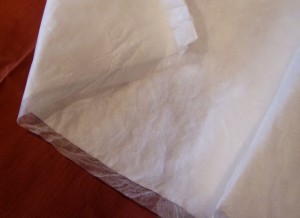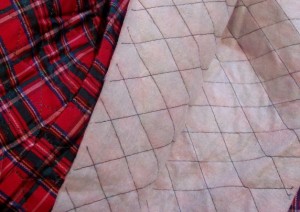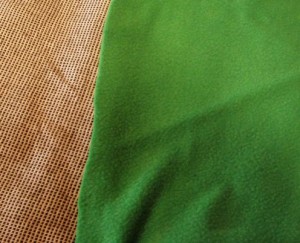 There are a couple of issues when you are creating a zip-out lining for a raincoat.
There are a couple of issues when you are creating a zip-out lining for a raincoat.
1. How are you going to be using this garment? Going to work? A child’s garment for going to school or play? Casual wear?
2. How much movement is involved?
Someone who will be wearing a coat such as this and standing out on a cold, windy train platform has much different needs than a child walking to school on a rainy day or someone hiking. The more movement there is, the more heat the person is going to generate on their own, and actually the less insulation they actually need in a zip-out lining. On the other hand, you also want to balance off the ability of the insulating materials you are going to use against appearances as well. For example, someone who is standing out on a cold train platform or in a bus shelter, shifting from foot to foot, needs as much warmth as you can give them — but from a ‘tailored business appearance’ standpoint, they are also not necessarily going to want to look like Bibendum (the Michilin Man tm). So, compromises will be made, whether you want them or not.
This is a review of what is available to home sewers in terms of insulating fabrics and some of their characteristics, which I have categorized as ‘Synthetic, down-like fabrics’, Quilted linings, natural fabrics and fleeces.
Synthetic, down-like fabrics:
There are a bunch of these out there, but not all of them are available to home sewers. So, if you want to go this route, be prepared to have only two or at the most three of these available to you.
Thinsulate: This is the grand-daddy of the synthetics and probably has the greatest warmth-to-thickness/weight of any of them. This is fairly easy to find and as you can see from the photo at the top, comes with a scrim on one side. It also comes in variously thicknesses and weights, which makes it very popular for use in items such as hats, gloves and mittens, footwear, and clothing. It also tends to be the least expensive. From a technical standpoint, the manufacturer, 3M, has gone with small diameter, mixed polymer fibers to provide insulation, so that more fibers can be packed in the same space to more efficiently trap air and reflect more radiating heat back.
Primaloft: Primaloft(tm) took the opposite end of the spectrum in terms of what they do, which is they see themselves as the synthetic alternative to goose down, which in a lot of outdoor applications such as sleeping bags and clothing, has been the ‘gold standard’ for at least a century. This technology uses soft short-strand fibers made from microfiber polyester, is highly compressible and like down, traps a lot of warmth. It also tends to have a very down-like (that is, puffy) appearance. It also tends to be much more expensive than Thinsulate, but if what you are doing is comforters or a ‘puffer’ jacket, then this is an excellent way to go. Again – this is like Thinsulatte in that it comes on a scrim and also comes with a certain amount of pre-quilting.
There are other synthetics out there, such as Thermolite(tm) and Climashield(tm) as well as proprietary ones developed for clothing manufacturers such as The North Face(tm), but I have not been able to find any retailers who sell them, except in the case of Climashield which is sold by Outdoor Wilderness Fabrics. A note on Climashield which makes it different from Thinsulate and Primaloft — it is continuous filiment insulation and does not come with a scrim and supposedly does not need a backing fabric. I’m not sure how you keep it tidy in clothing applications if you do not put some sort of lining on both sides, but that is just me.
 Quilted Lining Fabrics
Quilted Lining Fabrics
This is an item which is very easily found, even in your local ‘extremely large chain hobby store masquerading as a fabric store’ sort of place. This is a polyester batting which is quilted onto some sort of taffeta, nylon, or polyester fabric and backed with a thin polyester interfacing-like fabric. You can use this sort of thing to make everything from vests to linings to fancy quilted robes and home decor items such as bed covers and pillow shams. It also comes in various thicknesses. These can be very dressy and at certain thicknesses, can even be tailored to fit with darts and princess seams. The insulating qualities do not match the synthetic insulations above but you can increase their warmth factor by backing them with something else such as wool fabrics, a heavy flannelized satin or fleece.
And speaking of wool and fleece — here are just a couple of examples. Obviously, if you are making a raincoat or trench coat that you wish to copy the look of an expensive British-made coat, you will want to use a wool (or wool blend) blend fabric, plaid preferably as that is traditional If you use 100% wool, you can also run it through the washer and dryer and shrink it, which will help with making it more wind-proof. The one down-side to wool is weight. Although wool has been the ‘gold standard’ for warmth (even when wet) for literally thousands of years, warmth and weight go hand in hand here. The heavier the wool fabric is, the warmer it is, which for some folks is onerous. One way to deal with that issue and still get the look of wool is to get a thinner wool fabric (such as a wool or wool-blend suiting fabric and back it with something like quilted lining (with the batting side in and the fancy quilted fabric side out (and then you could, if you want to, make the lining reversible), or back it with flannelized satin with the flannel side in, or one of the ‘metalized’ lining fabrics with the reflecting side in. Another option is polyester fleece. My one beef with these fabrics is that they tend to sag vertically in long raincoat lining applications. I have, however, had good experiences lessening the tendency here by quilting them onto lining backer fabrics before I cut out the pieces of the lining and sewing them together in terms of the zip-out lining retaining its shape.
Another possibility, if you don’t want to order fabrics through the mail and only have your ‘large national chain hobby store masquerading as a fabric store’ in your area is to make your own quilted lining fabric, using polyester quilt batt fabrics. This comes in various thicknesses in a roll (if you are making a lining for an adult, you’ll need a twin-size batt). You will also need lining fabric for the ‘next to you’ side and a backer fabric of some sort, exactly as you would need if you were making a quilt. You have the choice of taking the three pieces of fabric and sandwiching the batt in between and quilting them together or cutting out all three fabrics according to the pattern pieces and sandwiching them together, basting them at the edges and quilting them (in as simple or complex a manner as you like – simple channel quilting works well for this application). Then, you will need to, at the seam lines, remove the batting so that you can sew the pieces of the lining together. It’s a bit of a fuss, but it does give a nice result. However, from a total cost perspective, you actually can do better with one of the synthetic applications named above.

